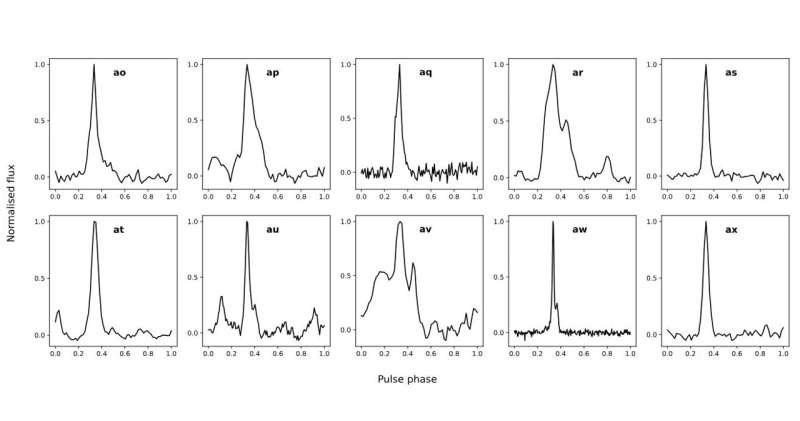April 2, 2024 report
This article has been reviewed according to Science X's editorial process and policies. Editors have highlighted the following attributes while ensuring the content's credibility:
fact-checked
preprint
trusted source
proofread
Astronomers find 10 new millisecond pulsars in globular cluster Terzan 5

Using the MeerKAT radio telescope, an international team of astronomers has detected 10 new millisecond pulsars in a Galactic globular cluster known as Terzan 5. The finding, which makes Terzan 5 the most pulsar-rich globular cluster, was reported in a research paper published March 26 on the pre-print server arXiv.
Pulsars are highly magnetized, rotating neutron stars emitting a beam of electromagnetic radiation. The most rapidly rotating pulsars, with rotation periods below 30 milliseconds, are known as millisecond pulsars (MSPs). Astronomers assume that they are formed in binary systems when the initially more massive component turns into a neutron star that is then spun up due to accretion of matter from the secondary star.
Discovered in 1968, Terzan 5 is a globular cluster (GC) located in the Milky Way's bulge, some 18,800 light years away. It has a radius of 2.7 light years, mass of about 2 million solar masses, and is estimated to be 12 billion years old. Given that Terzan 5 has been known for decades, it is one of the most widely studied GCs, and previous observations have found that it hosts a numerous population of pulsars, including MSPs.
The presence of many pulsars in Terzan 5 may still be undisclosed and it is estimated that this cluster may contain even 200 such objects. Therefore, a team of astronomers led by Prajwal Padmanabh of the Max Planck Institute for Gravitational Physics in Hannover, Germany, has observed Terzan 5 with the MeerKAT radio telescope using the L-Band (856–1,712 MHz) receiver, hoping to identify new pulsars in this cluster.
As a result, Padmanabh's team detected 10 new MSPs, out of which nine turned out to be binary systems. After the discovery, Terzan 5 now hosts 49 pulsars, which is so far the highest number for any known globular cluster.
The newfound MSPs have spin periods between 1.25 and 4.54 milliseconds, while their dispersion measures are similar—within a range of 235.44–239.46 pc/cm3. The astronomers managed to derive the characteristic age for five of the newly detected pulsars and it is generally between 1.3 and 3.18 billion years.
The researchers underlined that the only isolated pulsar in the sample, designated Ter5as, has a spin period of 2.32 milliseconds and many of its parameters still remain unknown. Four pulsars in the sample, namely Ter5au, Ter5ap, Ter5av, and Ter5ax likely have white dwarf companions with minimum masses within a range of 0.07–0.28 solar masses.
The authors of the paper noted that one of the newly found MSPs, designated Ter5ao, is an eccentric, wide-orbit pulsar with a large minimum companion mass of approximately 0.69 solar masses and a rapid spin period. These findings suggest that it may be a rare double neutron star (DNS) system.
More information: P. V. Padmanabh et al, Discovery and timing of ten new millisecond pulsars in the globular cluster Terzan 5, arXiv (2024). DOI: 10.48550/arxiv.2403.17799
Journal information: arXiv
© 2024 Science X Network





















